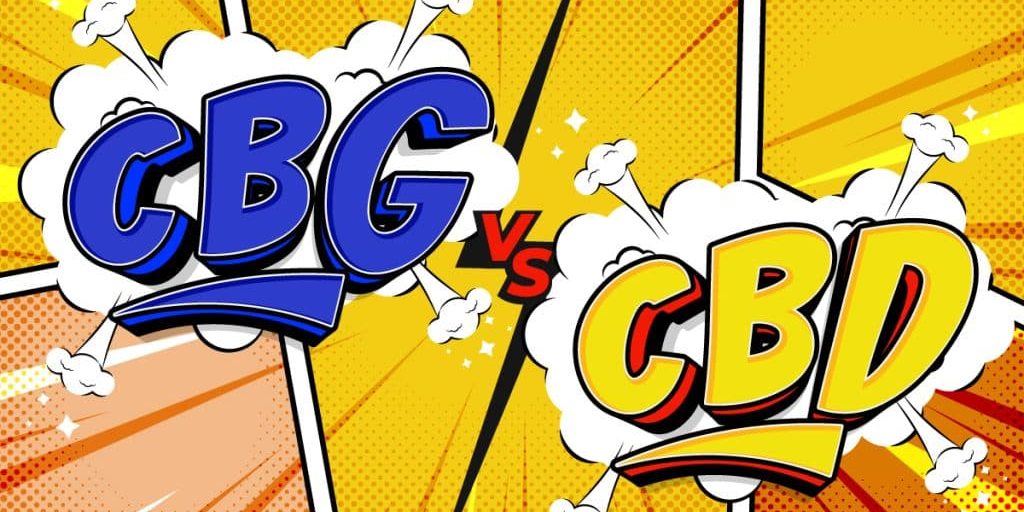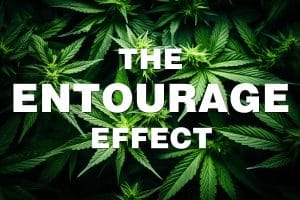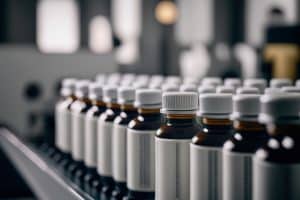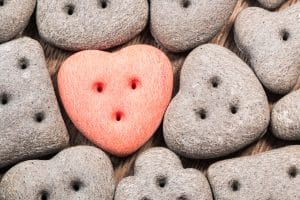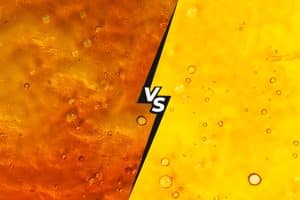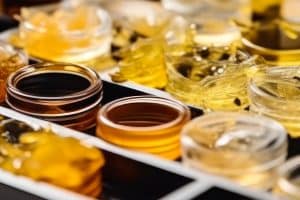First up in today’s CBD vs CBG match-up, we have the major cannabinoid CBD. Raw cannabis sativa is loaded with this non-psychoactive cannabinoid, giving CBD its “major” status. You can find it in oil tinctures, softgels, vapes, topicals, gummies — even CBD honey. The sky’s the limit when it comes to CBD product variety because it mixes well with just about everything!
CBD health benefits include pain relief, mood balance, anxiety reduction, anti-inflammatory effects, and support for healthy immune response.

RELATED ARTICLE: CBD For Muscle Recovery Post Workout
Synthesis of CBD
CBD is synthesized from Cannabidiolic Acid (CBDA) in the hemp plant’s trichomes. Trichomes are the tiny glands in the cannabis plant’s stems, leaves, and flowers. The sticky resin they produce is packed with natural medicines like cannabinoids, terpenes, flavonoids, and polyphenols.
Light and heat exposure cause a chemical reaction called “decarboxylation” that changes CBDA into the pharmacologically active medicine Cannabidiol, or CBD for short.
How CBD works
Scientists once thought CBD interacted with the cannabinoid receptors CB1 and CB2 until several studies revealed something surprising: CBD does not bind or directly interact with CB1 or CB2 receptors at all!
Initially, this discovery perplexed researchers until they tested other receptor sites and hit the jackpot. In a follow-up study, CBD was confirmed to bind with TRPV-1, a receptor site that senses pain and helps the human body respond to injury. TRPV-1 receptor sites may also modulate the release of neurotransmitters like Serotonin and Dopamine when activated by CBD stimulation.
TRPV-1 receptors cross-talk with the receptors in your endocannabinoid system (ECS), meaning one system can respond to what the other is doing. That’s how activating TRPV-1 receptors using CBD can help your body decrease pain sensitivity, control inflammation, fortify its stress response, boost mood, relieve anxiety, and support sleep/wake rhythms directly without using ECS receptor sites.
Recommended CBD dose
How much CBD you need is based on your body weight but may also depend on other factors, such as your specific wellness concerns, CBD tolerance, and how you take it (e.g., under the tongue, topical, or vape).
CBG goes head-to-head vs CBD
CBG is a minor cannabinoid that’s earned the impressive title of the “Rolls Royce of Cannabinoids” because, like the elite car brand, it’s powerful but rare to find. In full spectrum extracts, for example, CBG only makes up about one-half to one percent of the total cannabinoid concentration. Hence its “minor” moniker.
SHOP: 98.5% pure CBG isolate oil from Zero High® brand
So, why do we find only tiny amounts of CBG in cannabis sativa? Let’s explore that in the next section.
Synthesis of CBG
Did you know that, besides garnering the title of the “Rolls Royce of Cannabinoids,” CBG is also known as the “The Mother of All Cannabinoids?” True story!
CBG is synthesized from Cannabigerolic acid (CBGA) through decarboxylation, a non-enzymatic process as the cannabis plant matures. Most of the CBGA produced by the cannabis plant is transformed into either THCA (Tetrahydrocannabinolic acid) or CBDA (Cannabidiolic acid), leaving little of the substance left to become CBG.
But leave it to someone with a bit of creative ingenuity to come along and shake things up with selectively bred hemp strains that produce higher CBG levels naturally. These remarkable plants inhibit the enzyme reaction needed to convert CBGA to another cannabinoid, leaving more available to turn into CBG through decarboxylation.
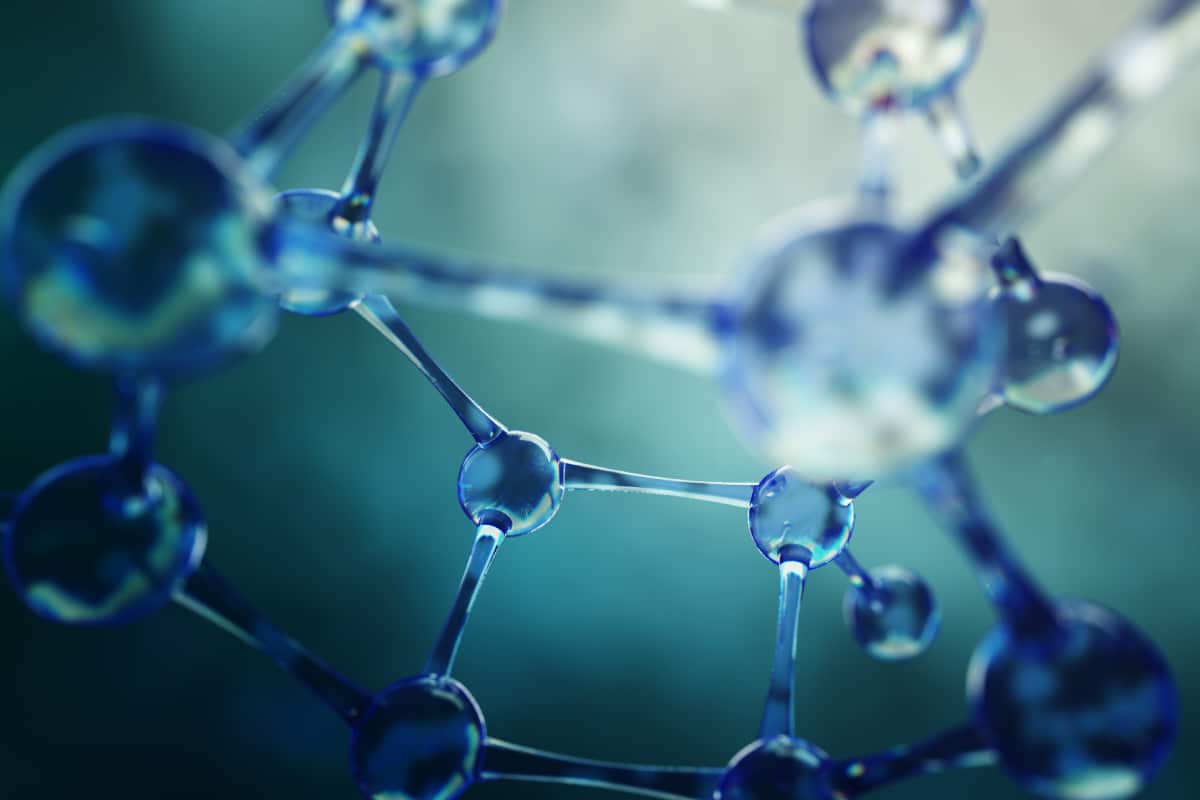
RELATED ARTICLE: CBG and What It’s Good For
How CBG works
CBG pharmacology — how it works in your body to help you feel better — is set apart from other cannabinoid compounds.
What’s unique about CBG is it binds or interacts with multiple receptor sites, giving it wide-ranging therapeutic benefits. Cannabinoid receptors CB1 and CB2, TRPV-1, and 5-HT1A Serotonin receptors have all been identified as potential CBG binding sites. So have lesser-known PPAR nuclear transcription receptors that operate within cells to affect inflammatory response and other physiological processes. Each system operates independently but communicates with the others to regulate mood balance, blood pressure, immune function, pain tolerance, and many more physiological processes.
Recommended CBG dose
How much CBG you need is based on your body weight but may also depend on other factors, such as your specific wellness concerns, the tone of your endocannabinoid system, and how you take it (e.g., orally, under the tongue, topically, or vape).
Review our CBG Dosage Guide if this is your first time taking CBG and you’re not sure how much you need to start.
CBD vs CBG: Who comes out on top?
The shocking results of this head-to-head match-up are in…
It’s a tie! 😵
Both cannabinoids are winners. They just come out on top in slightly different ways.
Some cannabis research even shows combining cannabinoid compounds amplifies potential benefits, making them an even more effective treatment than taking one or the other individually. Scientists coined the term “entourage effect” to describe this natural phenomenon when they observed that full spectrum extracts produce more robust benefits than CBD isolate.
In short, the more cannabinoids and other natural cannabis medicines in your CBD extract — like terpenes, flavonoids, and polyphenols — the better it relieves your everyday wellness concerns.
That’s why choosing True Full Spectrum CBD oils like Cannabiva is important. Our whole-plant harvest and extraction process preserves the delicate balance of natural medicines to ensure you get a CBD extract loaded with plant power!
Similarities between CBG and CBD
CBG vs CBD have many more similarities than differences based on everything we’ve learned so far.
Let’s review what we know about these two powerful plant medicines and explore how CBG and CBD are better off as partners than opponents:
- Both are non-intoxicating and cannot cause psychoactive effects after taking them
- Both interact with or influence the endocannabinoid system (ECS) to relieve everyday wellness concerns
- Both relieve nervous tension, promote positive mood balance, and have anxiolytic properties
- Both have analgesic properties that are soothing, calming, and anti-inflammatory
- Both can be used in various product types, from oil tinctures, softgels, topicals, edibles, vapes, and more
CBG and CBD indeed have many similarities, but they share a few key differences that distinguish them. Let’s review what makes each cannabinoid unique.
CBG vs CBD differences
CBG and CBD molecules have chemical structures that allow them to interact with the human body in powerful ways. Molecule shape is the primary difference between both cannabinoids.
Think of a cannabinoid much like a key — the key with the right shape opens a locked door. The particular chemical structure of a cannabinoid gives it the right shape to fit into a receptor site and unlock health benefits.
Chemical structure
CBD molecules have a distinct ring structure that gives them unique properties. Its ringed molecular structure turns CBD into a special kind of key that can change shape depending on certain enzymatic processes. As a result of its unique chemical structure, CBD unlocks a wide range of benefits for many people.
Instead of a closed ring, CBG molecules have more of a straight chain open shape with extra hydrogen atoms. Its form may not be as fancy as its ringed chemical cousin, but CBG’s slightly different shape does the trick. It allows CBG to bind and interact with numerous receptor sites to relieve wellness concerns.
Affinity for endocannabinoid receptors
CBG and CBD have a different affinity for cannabinoid receptors in the endocannabinoid system (ECS). Let’s explore what that means and how it affects the way they work to help you feel better.
CBD has a very “low affinity” for CB1 and CB2 endocannabinoid receptors. In other words, it is like a key that might fit the keyhole but can’t actually turn the lock to open it. Because it doesn’t fit just right, CBD cannot promote any benefit directly through the ECS. But remember, CBD has other ways to influence the ECS without interacting directly. Namely, TRPV-1 receptors that cross-talk with the ECS.
CBG, on the other hand, has a very “high affinity” for CB1 and a lower affinity for CB2 receptors. As a result, CBG unlocks many CB1 receptors and some CB2 receptors.
Natural concentration in the hemp plant
CBD is a major cannabinoid, so you’ll find significant levels in cannabis plants. Raw full spectrum extracts contain about 60 to 70 percent Cannabidiol.
Compare those levels to CBG, often found in tiny amounts from one-half to one percent of the total cannabinoid concentration. CBG is a precious substance, indeed. Technological improvements have made it possible to radically purify our raw extract into a pharmaceutical-grade isolate powder with over 98.5% pure Cannabigerol.
SHOP: Add 98.5% pure CBG isolate powder to your wellness plan
What is the difference between CBG and CBGA?
Ever scratched your head trying to figure out the whole CBG vs CBGA thing? You’re not alone! Here’s a quick breakdown to clear things up:
- CBGA is an acidic cannabinoid that acts as a precursor — or building block — to many other cannabinoids, including CBD, THC, and CBG. CBGA does not appear to have any therapeutic properties.
- CBG is a pharmacologically active minor cannabinoid that promotes therapeutic benefits when used as a natural medicine.
- CBG is usually present in lower concentrations in cannabis plants than CBGA
Easy peasy! That’s the skinny on CBG and CBGA. Next, let’s review what you need to know before taking CBG for the first time.
How to use CBG and CBD
Whether you take CBG and CBD together or separately, finding your correct dosage is essential for best results. Refer to the following quickstart guidelines before taking any hemp plant extract for the first time.
Titration
Titration is when you gradually increase or modify your daily dose. You start with the minimum effective treatment dose, then take more or less, depending on your response. Titrating can take as little as a few days up to a couple of weeks. Remember that everyone is unique, and your results may vary from those of other individuals taking CBG or CBD.
CBG and CBD dosage
There is no one-size-fits-all solution to how much CBG or CBD to take because everybody is different. That’s why it’s best to begin with the minimum effective dose and work your way up to a level that’s right for you.
Review our CBG dosage chart and CBD dosing chart for an at-a-glance look at how much to take according to your body weight.
How to combine CBD and CBG
CBD and CBG naturally occur in the cannabis plant, so taking them together will not cause an interaction. However, doing so may cause an amplification of each cannabinoid’s individual effects through a phenomenon scientists call the entourage effect.
Keep the entourage effects in mind when combining CBG and CBD, and refer to these quickstart safe usage guidelines before first use:
- Start with the lowest effective dose and use trial and error to determine the amount that works best for you
- When it comes to mixing CBG and CBD for the first time, a good starting ratio is 1:1, but do what feels right for you and adjust as needed
- Side effects are rare but may include dry mouth, gastrointestinal discomfort, drowsiness, or sleepiness in less than one-half of one percent (<0.5%) of individuals, according to Cannabiva usage statistics
Cannabiva free CBD samples are the perfect way to combine the effects of CBG, CBD, and other cannabinoids into an easy-to-take daily dose.
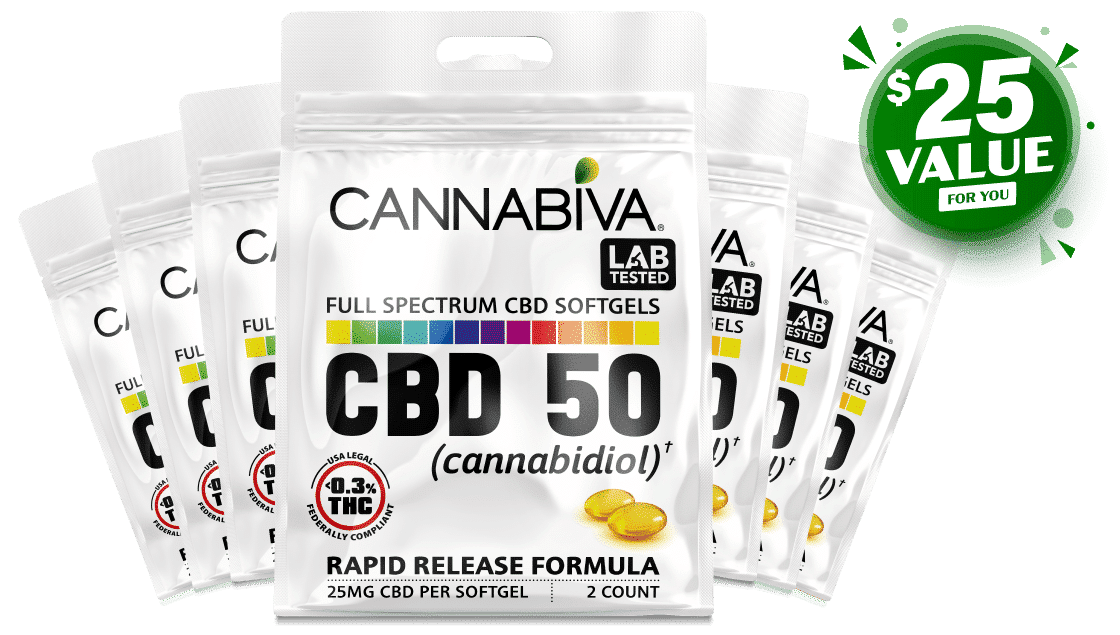
FREE CBD SAMPLES FOR YOU: Claim your 7-day trial now
The effects and benefits of CBG vs CBD
CBD always steals the spotlight when people talk about hemp-derived extracts. And it is with good reason. CBD is backed by decades of research that show it can help relieve everyday wellness concerns, from stress, anxiety, and trouble sleeping to aches, pains, and inflammation.
But that’s all changing as research into the therapeutic effects of CBG gathers steam. The latest CBG studies show promising results for what many people who take CBG already know:
CBG can help with many of the same everyday wellness concerns that CBD can, and we’ve got the studies to prove it! Let’s follow the science and explore the many ways CBG can help you feel better.
CBG for anxiety and depression
Participants using CBG-dominant cannabis were asked to rate its efficacy in one study published in the October 2022 issue of Cannabis and Cannabinoid Research. Study participants reported that CBG-dominant cannabis was an effective treatment for chronic pain, depressed mood, anxiety, stress, and trouble sleeping symptoms. Most patients reported high efficacy levels and indicated their conditions had “much improved” or “very much improved” over six months of use.
CBG for inflammation
Studies show CBG exhibits anti-inflammatory properties in vitro, suggesting it may help manage the inflammatory response in the human body. One research study shows that CBG can protect cells from free radicals. Results from that study show a reduction of inflammatory markers that indicate damage to cells. Scientists also discovered that CBG stops harmful oxidative effects inside cells and boosts the cell’s own protective healing mechanism.
CBG for gut health
According to a 2013 study published in Biochemical Pharmacology, taking CBG may support gut health through its anti-inflammatory properties. Researchers created in vitro models to study the anti-inflammatory response of CBG using intestinal epithelial cells. Results show CBG lowered inflammatory markers, helped regulate healthy immune response, and reduced the harmful effects of oxidative stress.
CBG for antibacterial purposes
A mini-review of studies published in The Journal of Pharmacology and Experimental Therapeutics found that CBG exhibited antibacterial effects against various bacteria strains. These findings suggest that CBG supports the body’s natural healing process and may speed recovery when applied topically to minor cuts, scrapes, and burns.
CBG brain effects
Research models in vitro show the combination of CBG and CBD is superior to either cannabinoid administered alone for anti-inflammatory and antioxidant effects in the brain. Another in vitro model study investigating the antioxidant and anti-inflammatory response of CBG found it had a neuroprotective impact and antioxidant properties.
Which CBG and CBD products are right for me?
Now, for the really fun part. Let’s talk about the most popular CBG and CBD product types to help you find the best one.
Full spectrum
CBD is a major component of full spectrum extracts. Typically, raw extracts contain 60 to 70 percent CBD along with other compounds, like — you guessed it — tiny amounts of CBG (less than one percent of the total cannabinoid concentration).
Discover the benefits of true full spectrum CBD oil from Cannabiva. Our whole-plant harvest and extraction process preserves the delicate balance of natural medicines like CBG and CBD. As a result, you get a hemp extract loaded with cannabis plant power.
Broad spectrum
Broad spectrum CBD is everything you love about full spectrum, except there’s no THC!
Broad spectrum extracts do have trace amounts of THC. These amounts are so small that they cannot be detected (0.0%) using standard lab testing procedures. Most broad spectrum extracts range between 70 to 80 percent CBD. CBG is one-half to one percent of the total cannabinoid concentration of a high-quality broad spectrum extract.
Pure isolate CBD oil
Sometimes, getting the strongest CBD potency is important for a cannabis user. Pure isolate CBD oil is like pristine nectar from the gods for these lucky seekers!
Zero High brand CBD isolate oil is made from pharmaceutical-grade 99.7 percent pure CBD. It’s radically purified to contain only Cannabidiol and no other cannabinoid compounds — not even a hint of THC (0.00%). Isolate oil is the perfect option if your primary concern is maximum potency and purity or avoiding THC altogether.
Pure isolate CBG oil
Consider this: The average full spectrum extracts contain just one percent or less CBG. Now compare that to Zero High isolate CBG oil made with radically purified cannabis extract that’s over 98.5% pure CBG — so pure, it’s clear℠.
Take CBG alone or add it to your CBD wellness plan to promote a broader range of positive effects.
Combining CBG and CBD oils
Get ready to experience maximum cannabis health benefits when you combine CBG and CBD!
Taking CBG and CBD together amplifies their individual therapeutic benefits to promote a natural phenomenon scientists call the entourage effect. This powerful synergy occurs when two or more cannabinoids are combined. According to research, the more cannabinoids your hemp extract contains, the more effectively it works to help you feel better.
TIP: Always start low and go slow when taking CBG oil and CBD oil together until you know how the combination affects you.
CBG vs CBD FAQ
Get the CBG and CBD answers you need. Browse our FAQ or ask a Cannabiva Wellness Advisor if you have a CBG or CBD product question we haven’t answered today.



